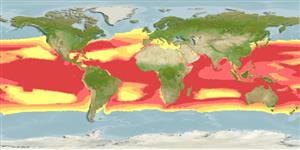>
Scombriformes (Mackerels) >
Scombridae (Mackerels, tunas, bonitos) > Scombrinae
Etymology: Acanthocybium: Greek, akantha = thorn + Greek, kybion. -ou = a tunna (Ref. 45335).
More on author: Cuvier.
Environment: milieu / climate zone / depth range / distribution range
Ecologia
marinhas; oceanódromo (Ref. 51243); intervalo de profundidade 0 - 20 m (Ref. 89972), usually 0 - 12 m (Ref. 5227). Subtropical; 59°N - 48°S, 180°W - 180°E
Atlantic, Indian and Pacific Oceans: in tropical and subtropical waters, including the Caribbean and Mediterranean seas.
Comprimento de primeira maturação / Tamanho / Peso / Idade
Maturity: Lm 99.3, range 85 - 105 cm
Max length : 250 cm TL macho/indeterminado; (Ref. 30573); common length : 170 cm FL macho/indeterminado; (Ref. 9340); peso máx. publicado: 83.0 kg (Ref. 168)
Espinhos dorsais (total) : 23 - 27; Raios dorsais (total) : 12 - 16; Espinhos anais: 0; Raios anais : 12 - 14; Vértebras: 62 - 64. Mouth large with strong, triangular, compressed and finely serrate teeth. Snout about as long as the rest of head. Posterior part of maxilla completely concealed under preorbital bone. Gill rakers absent. Interpelvic process small and bifid. Swim bladder present. Body covered with small scales. No anterior corselet developed. The back is iridescent bluish green; the sides silvery with 24 to 30 cobalt blue vertical bars which extend to below the lateral line.
An oceanic, epipelagic species frequently solitary or forming small loose aggregations rather than compact schools. Feed on fishes and squids. Eggs and larvae are pelagic (Ref. 6769). An important sport fish in some areas (Ref. 9340). Marketed fresh, salted or spice-cured slices of meat; also frozen (Ref. 9987). Flesh of very good quality (Ref. 9684). Minimum depth from Ref. 005227.
Spawning seems to extend over a long period; fish in different maturity stages are frequently caught at the same time.
Collette, B.B. and C.E. Nauen, 1983. FAO Species Catalogue. Vol. 2. Scombrids of the world. An annotated and illustrated catalogue of tunas, mackerels, bonitos and related species known to date. Rome: FAO. FAO Fish. Synop. 125(2):137 p. (Ref. 168)
Status na Lista Vermelha da UICN (Ref. 130435)
Ameaça para os humanos
Reports of ciguatera poisoning (Ref. 30298)
Uso pelos humanos
Pescarias: espécies comerciais; peixe esportivo: sim
Ferramentas
Relatórios especiais
Baixar XML
Fontes da internet
Estimates based on models
Preferred temperature (Ref.
123201): 18.2 - 27.6, mean 24.7 °C (based on 46871 cells).
Índice de diversidade filogenética (Ref.
82804): PD
50 = 1.0000 [Uniqueness, from 0.5 = low to 2.0 = high].
Bayesian length-weight: a=0.00282 (0.00202 - 0.00393), b=3.17 (3.07 - 3.27), in cm total length, based on LWR estimates for this species (Ref.
93245).
Nível Trófico (Ref.
69278): 4.3 ±0.2 se; based on diet studies.
Resiliência (Ref.
120179): médio(a), tempo mínimo de duplicação da população 1,4 - 4,4 anos (K=0.34; tm=1-2 y; tmax >4; Fec=6 million).
Prior r = 0.84, 95% CL = 0.55 - 1.26, Based on 1 full stock assessment.
Fishing Vulnerability (Ref.
59153): Moderate to high vulnerability (46 of 100).
Climate Vulnerability (Ref.
125649): Very high vulnerability (76 of 100).
Nutrients (Ref.
124155): Calcium = 34.8 [17.2, 70.3] mg/100g; Iron = 1.34 [0.70, 2.53] mg/100g; Protein = 21.8 [20.5, 23.1] %; Omega3 = 0.183 [0.092, 0.379] g/100g; Selenium = 28 [13, 64] μg/100g; VitaminA = 6.92 [2.08, 25.10] μg/100g; Zinc = 0.423 [0.273, 0.649] mg/100g (wet weight);
